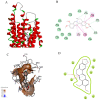Inhibitory Effect of Berberine on Broiler P-glycoprotein Expression and Function: In Situ and In Vitro Studies
- PMID: 31013627
- PMCID: PMC6515058
- DOI: 10.3390/ijms20081966
Inhibitory Effect of Berberine on Broiler P-glycoprotein Expression and Function: In Situ and In Vitro Studies
Abstract
Overcoming P-glycoprotein (P-gp) efflux is a strategy to improve the absorption and pharmacokinetics of its substrate drugs. Berberine inhibits P-gp and thereby increases the bioavailability of the P-gp substrate digoxin in rodents. However, the effects of berberine on P-gp in chickens are still unclear. Here, we studied the role of berberine in modulating broilers P-gp expression and function through both in situ and in vitro models. In addition, molecular docking was applied to analyze the interactions of berberine with P-gp as well as with chicken xenobiotic receptor (CXR). The results showed that the mRNA expression levels of chicken P-gp and CXR decreased in the ileum following exposure to berberine. The absorption rate constant of rhodamine 123 increased after berberine treatment, as detected using an in situ single-pass intestinal perfusion model. Efflux ratios of P-gp substrates (tilmicosin, ciprofloxacin, clindamycin, ampicillin, and enrofloxacin) decreased and the apparent permeability coefficients increased after co-incubation with berberine in MDCK-chAbcb1 cell models. Bidirectional assay results showed that berberine could be transported by chicken P-gp with a transport ratio of 4.20, and this was attenuated by verapamil (an inhibitor of P-gp), which resulted in a ratio of 1.13. Molecular docking revealed that berberine could form favorable interactions with the binding pockets of both CXR and P-gp, with docking scores of -7.8 and -9.5 kcal/mol, respectively. These results indicate that berberine is a substrate of chicken P-gp and down-regulates P-gp expression in chicken tissues, thereby increasing the absorption of P-gp substrates. Our findings suggest that berberine increases the bioavailability of other drugs and that drug-drug interactions should be considered when it is co-administered with other P-gp substrates with narrow therapeutic windows.
Keywords: MDCK-chAbcb1 cell line; P-glycoprotein; berberine; chicken; inhibition.
Conflict of interest statement
The authors declare that they have no conflict of interest. The funders had no role in the design of the study; in the collection, analyses, or interpretation of data; in the writing of the manuscript, or in the decision to publish the results.
Figures









Similar articles
-
Potential pharmacokinetic effect of rifampicin on enrofloxacin in broilers: Roles of P-glycoprotein and BCRP induction by rifampicin.Poult Sci. 2016 Sep 1;95(9):2129-35. doi: 10.3382/ps/pew148. Epub 2016 Apr 26. Poult Sci. 2016. PMID: 27118859
-
Use of quercetin in animal feed: effects on the P-gp expression and pharmacokinetics of orally administrated enrofloxacin in chicken.Sci Rep. 2018 Mar 13;8(1):4400. doi: 10.1038/s41598-018-22354-1. Sci Rep. 2018. PMID: 29535328 Free PMC article.
-
Using the lentiviral vector system to stably express chicken P-gp and BCRP in MDCK cells for screening the substrates and studying the interplay of both transporters.Arch Toxicol. 2018 Jun;92(6):2027-2042. doi: 10.1007/s00204-018-2209-9. Epub 2018 May 3. Arch Toxicol. 2018. PMID: 29725709
-
Approaching strategy to increase the oral bioavailability of berberine, a quaternary ammonium isoquinoline alkaloid: part 2. development of oral dosage formulations.Expert Opin Drug Metab Toxicol. 2023 Mar;19(3):139-148. doi: 10.1080/17425255.2023.2203858. Epub 2023 Apr 20. Expert Opin Drug Metab Toxicol. 2023. PMID: 37060323 Review.
-
The structure and functions of P-glycoprotein.Curr Med Chem. 2010;17(8):786-800. doi: 10.2174/092986710790514507. Curr Med Chem. 2010. PMID: 20088754 Review.
Cited by
-
Effect of topical berberine in murine cutaneous leishmaniasis lesions.J Antimicrob Chemother. 2022 Mar 31;77(4):1072-1081. doi: 10.1093/jac/dkac007. J Antimicrob Chemother. 2022. PMID: 35086139 Free PMC article.
-
Probiotics, Prebiotics, and Phytogenic Substances for Optimizing Gut Health in Poultry.Microorganisms. 2022 Feb 8;10(2):395. doi: 10.3390/microorganisms10020395. Microorganisms. 2022. PMID: 35208851 Free PMC article. Review.
-
Uterine Metabolomic Analysis for the Regulation of Eggshell Calcification in Chickens.Metabolites. 2021 Aug 26;11(9):575. doi: 10.3390/metabo11090575. Metabolites. 2021. PMID: 34564391 Free PMC article.
-
Solid Lipid Nanoparticles for Duodenum Targeted Oral Delivery of Tilmicosin.Pharmaceutics. 2020 Aug 4;12(8):731. doi: 10.3390/pharmaceutics12080731. Pharmaceutics. 2020. PMID: 32759764 Free PMC article.
-
CDK6-PI3K signaling axis is an efficient target for attenuating ABCB1/P-gp mediated multi-drug resistance (MDR) in cancer cells.Mol Cancer. 2022 Apr 22;21(1):103. doi: 10.1186/s12943-022-01524-w. Mol Cancer. 2022. PMID: 35459184 Free PMC article.
References
MeSH terms
Substances
Grants and funding
LinkOut - more resources
Full Text Sources
Miscellaneous

